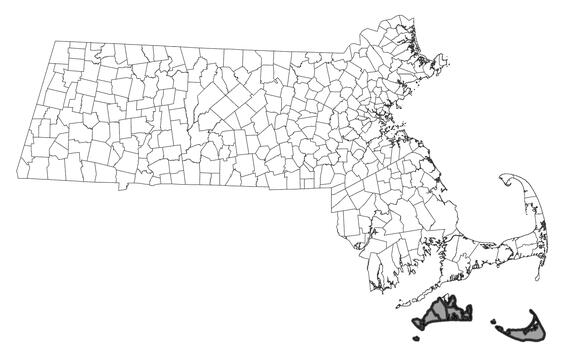- Scientific name: Sisyrinchium fuscatum E.P.Bicknell
- Species of Greatest Conservation Need (MA State Wildlife Action Plan)
- Special Concern (MA Endangered Species Act)
Description
Despite its name, sandplain blue-eyed grass (Sisyrinchium fuscatum) isn’t a grass, but rather a handsome perennial wildflower of the iris family (Iridaceae). Typically, 20-45 cm in height (8-17 in), the deep, green foliage forms small, dense tufts giving the plant an overall bunchgrass look. Brown, fibrous tufts found at the base are the remains of the previous year’s leaves. Stems and leaves are deep blue-green and glaucous, darkening to brown or black in drying. Linear, grass-like leaves are stiff (up to 3 mm wide; 0.04-0.1 in wide) and usually over half the height of the stem. Rigid stems (1-3 mm wide; 0.1 in wide) are often curved and flattened with distinct, stiff wings. An erect spathe continues the line of the stem past the terminal inflorescence. The bright violet-blue flowers are small (8-10 mm; 0.3-0.4 in) and often numerous; borne in pedicellate inflorescences at the plant apex, the flowers can number from three to twelve per plant. The tiny, bright yellow-orange anthers at the center of the flower starkly contrast with the purple petals creating the “eye” of the flower. Each flower yields two, small, globular fruits (3-5 mm; 0.1-0.2 in) which are brown. Fruit capsules contain many tiny-pitted seeds.
Sandplain blue-eyed grass is the only member of the genus with dense, fibrous tufts at the base of the plant. To find them, close examination of the leaf base may be necessary. Unlike other species of this genus in Massachusetts, this species is specific to open, dry, sandy coastal habitats. It flowers in early to midsummer and fruits late summer to early autumn.
Narrowleaf blue-eyed grass (S. angustifolium) and eastern blue-eyed grass (S. atlanticum) are both very similar to sandplain blue-eyed grass. In addition to having a distinctive fibrous base, sandplain blue-eyed grass is generally stiffer in habit than both species. It also has wider leaves and is more tufted than narrowleaf blue-eyed grass; further, the latter species also has a more broadly winged stem. The foliage of eastern blue-eyed grass is paler in color than sandplain blue-eyed grass. Other species in this genus known from Massachusetts include slender blue-eyed grass (S. mucronatum; Endangered) and strict blue-eyed grass (S. montanum), both of which have a single sessile inflorescence.
Life cycle and behavior
This is a perennial wildflower.

Population status
Sandplain blue-eyed grass is listed under the Massachusetts Endangered Species Act as a species of Special Concern. All listed species are protected from killing, collecting, possessing, or sale, and from activities that would destroy habitat and thus directly or indirectly cause mortality or disrupt critical behaviors. Sandplain blue-eyed grass is currently known from Nantucket and Dukes Counties and is historically known from Barnstable County.
Distribution and abundance
Sandplain blue-eyed grass is currently known from Florida north along the Atlantic coast to Massachusetts and New York with disjunct populations in Nova Scotia. It occurs west to Louisiana along the southern coast. It previously occurred in Michigan where it is now presumed extirpated. It is also possibly extirpated in Pennsylvania and Rhode Island. It is imperiled in Massachusetts, North Carolina and Virginia and critically imperiled in New York and Nova Scotia. It has not been assessed in other states.

Habitat
Sandplain blue-eyed grass inhabits sandy soils of early succession coastal sandplain grasslands. It is often found in isolated patches in full sun, where it can be locally abundant. Associates may include little bluestem (Schizachyrium scoparium), bushy rockrose (Crocanthemum dumosum), New England blazing star (Liatris novae-angliae; special concern), black huckleberry (Gaylussacia baccata), scrub oak (Quercusilicifolia), gray goldenrod (Solidago nemoralis), bushy aster (Symphyotrichum dumosum), beach pinweed (Lechea maritima), bearberry (Arctostaphylos uva-ursi), and low bush blueberry (Vaccinium angustifolium).
Healthy habitats are vital for supporting native wildlife and plants. Explore habitats and learn about conservation and restoration in Massachusetts.
Threats
Threats to this species include habitat loss due to development, and exclusion of fire or other disturbance, which can lead to competition from invasive and aggressive native species (e.g., black huckleberry, scrub oak).
Conservation
Burning, mowing, or some kind of soil scarification has been recommended to retard succession of woody species. Infrequent mowing has been shown to maintain site suitability in some areas. However, Clarke and Patterson (2007) found that sandplain blue-eyed grass may take a long time to become abundant in an area post-disturbance. This should be taken into account when developing a management plan. All active management of rare plant populations (including invasive species removal) is subject to review under the Massachusetts Endangered Species Act and should be planned in close coordination with the MassWildlife’s Natural Heritage Endangered Species Program.
References
Bicknell, E.P. 1899. Studies in Sisyrinchium-V: Two new Eastern species. Bulletin of the Torrey Botanical Club 26(9): 496−499.
Clarke, G.L., and W.A. Patterson III. 2007. The distribution of disturbance-dependent rare plants in a coastal Massachusetts sandplain: Implications for conservation and management. Biological Conservation 136: 4–16.
NatureServe. 2025. NatureServe Network Biodiversity Location Data accessed through NatureServe Explorer [web application]. NatureServe, Arlington, Virginia. Available https://explorer.natureserve.org/. Accessed: 6/2/2025.
Contact
| Date published: | June 10, 2025 |
|---|